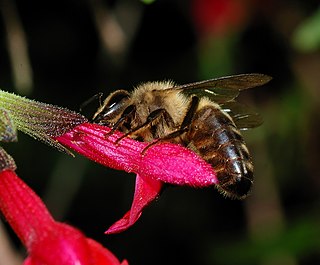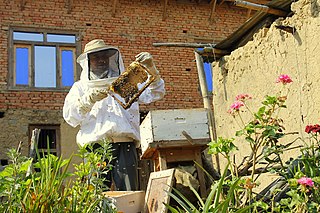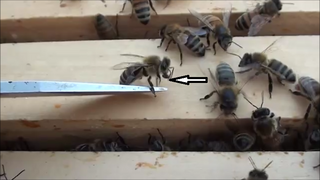
The Buckfast bee is a breed of honey bee, a cross of many subspecies and their strains, developed by Brother Adam, who was in charge of beekeeping from 1919 at Buckfast Abbey in Devon in the United Kingdom. Breeding of the Buckfast bee is now done by breeders throughout Europe belonging to the Federation of European Buckfast Beekeepers (G.D.E.B.). This organization maintains a pedigree for Buckfast bees, originating from the time of Brother Adam.

The Apis mellifera mellifera is a subspecies of the western honey bee, evolving in central Asia, with a proposed origin of the Tien Shan Mountains and later migrating into eastern and then northern Europe after the last ice age from 9,000BC onwards. Its original range included the southern Urals in Russia and stretched through northern Europe and down to the Pyrenees. They are one of the two members of the 'M' lineage of Apis mellifera, the other being in western China. Traditionally they were called the Black German Bee, although they are now considered endangered in Germany. However today they are more likely to be called after the geographic / political region in which they live such as the British Black Bee, the Native Irish Honey Bee, the Cornish Black Bee and the Nordic Brown Bee, even though they are all the same subspecies, with the word "native" often inserted by local beekeepers, even in places where the bee is an introduced foreign species. It was domesticated in Europe and hives were brought to North America in the colonial era in 1622 where they were referred to as the English Fly by the Native Americans.

THYMOVAR is a product to control the Varroa mite on bees and contains the essential oil thymol.

Varroa destructor, the Varroa mite, is an external parasitic mite that attacks and feeds on honey bees and is one of the most damaging honey bee pests in the world. A significant mite infestation leads to the death of a honey bee colony, usually in the late autumn through early spring. Without management for Varroa mite, honey bee colonies typically collapse within 2 to 3 years in temperate climates. These mites can infest Apis mellifera, the western honey bee, and Apis cerana, the Asian honey bee. Due to very similar physical characteristics, this species was thought to be the closely related Varroa jacobsoni prior to 2000, but they were found to be two separate species after DNA analysis.

The Russian honeybee refers to honey bees that originate in the Primorsky Krai region of Russia. This strain of bee was imported into the United States in 1997 by the USDA Agricultural Research Service's Honeybee Breeding, Genetics & Physiology Laboratory in Baton Rouge, Louisiana, in response to severe declines in bee populations caused by infestations of parasitic mites, and has been used in breeding programs to improve existing stocks. Many Russian queens openly mate with drones from various stock, creating colonies that are genetically hybrid. Some of these 'uncontrolled' hybrids may exhibit "increased aggressiveness, reduced honey production and a decrease in their ability to withstand mites and detrimental expressions of other traits as well."

Varroa is a genus of parasitic mesostigmatan mites associated with honey bees, placed in its own family, Varroidae. The genus was named for Marcus Terentius Varro, a Roman scholar and beekeeper. The condition of a honeybee colony being infested with Varroa mites is called varroosis.

Varroa jacobsoni is a species of mite that parasitises Apis cerana. The more damaging Varroa destructor was previously included under the name V. jacobsoni, but the two species can be separated on the basis of the DNA sequence of the cytochrome oxidase I gene in the mitochondrial DNA.

Apis koschevnikovi, Koschevnikov's honey bee, is a species of honey bee which inhabits Malaysian and Indonesian Borneo, where it lives sympatrically with other honey bee species such as Apis cerana.

The Maltese honey bee, Apis mellifera ruttneri, is a subspecies of the western honey bee, endemic to the Maltese islands which are situated in the Mediterranean Sea.
Beekeeping is first recorded in Ireland in the seventh century. It has seen a surge in popularity in modern times, with the membership of beekeeping associations exceeding 4,500. The median average number of hives per beekeeper is three hives, while the average honey output per hive is 11.4 kg. The growth in the practice has occurred despite increased pressures on bees and beekeepers due to parasites, diseases and habitat loss.

Nepal is known for its ancestral technology of beekeeping: geographical conditions and lack of modern equipment have forced the collectors to risk their lives. Apiculture in Nepal began 20 years ago but is still not very developed. Different species of honey-producing bees are found in Nepal. Only two of them are raised for apiculture: Apis cerana,Apis mellifera and Apis florea. These species have several qualities that are desired by humans and are vital for the pollination of flowers and forests. Bees are also useful for agriculture which is an important activity in Nepal but they have become threatened by deforestation and parasites.

Mite biting is one of the behavioral mechanisms of honey bees used to fight off the ectoparasitic mites Varroa destructor. This behavior has been studied since the late 1990s for honey bee breeding and improvement of honeybee stocks towards mite resistance. Krispn Given and Dr. Greg Hunt at Purdue University started a hierarchical selective breeding program in 1997–present for increased mite-biting and grooming behavior of European honey bee. A group of Midwest bee breeders visiting the Purdue bee lab were inspired to start the Heartland Honey Bee Breeders Cooperative as a result of their pioneering work.
Apis mellifera adansonii(Western African bee) is a subspecies of the Western honey bee with probably the largest range of Apis mellifera in Africa, belonging to the A (Africa) Lineage of honey bees. Originally identified by Michael Adansonin in his Histoire naturelle du Seneegal in 1757. Initially the name adsansonii was misapplied to A. m. scutelleta and in particular to the Africanised bees of South America.
Apis mellifera monticola is known by the common name of the East African mountain honey bee. In 2017 its complete mitochondrial genome was sequenced, confirming that it belonged to the A Lineage of honey bees and concluding that "A phylogenetic tree showed that A. m. monticola clusters with other African subspecies".

Apis mellifera unicolor is known by the common name of the Madagascar honey bee, sometimes also called the Malagasy honey bee. It is endemic to the island of Madagascar.

Apis mellifera syriaca is known by the common name of the Syrian honey bee, sometimes also called the Palestine honey bee.
Varroa rindereri is an external parasitic mite that feeds on honey bees. The only known honey bee species it feeds on is Apis koschevnikovi
Varroa underwoodi is a mite that feeds on honey bees. It is an external parasite of the western honey bee, Asian honey bee, A. nigrocincta, and A. nuluensisV. underwoodi has been found on multiple bee species in Southern Asia, though has only been found on the Asian honey bee in China. The smallest sized V. underwoodi was collected from Papua New Guinea from western honey bee hives.












